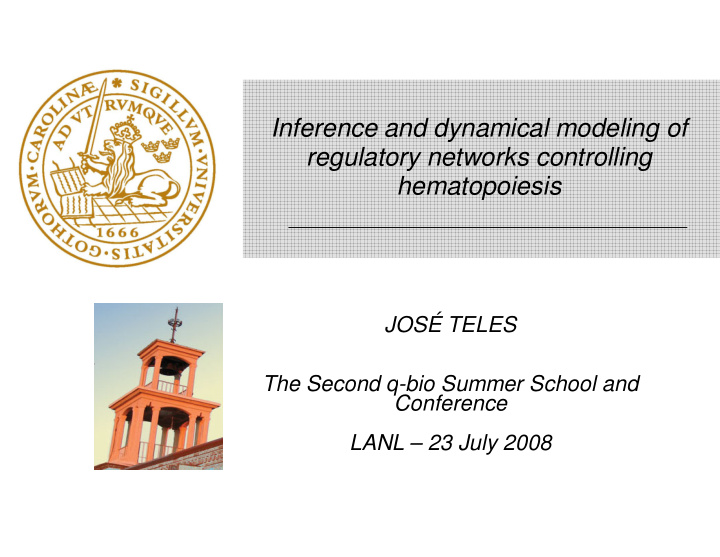



Inferenc nce and dynamical modeling of regul ulatory networks controlling hematopoiesis JOSÉ TELES The Secon cond q-bio Summer School and Conference L LANL – 23 July 2008
OUTL TLINE I. INTRODUCTION II. (BROAD) PROJECT DE ESCRIPTION III. CURRENT WORK IV. IMMEDIATE PROSPEC ECTS
PhD @ @ Lund CARSTEN PETERSON
PhD @ @ Lund
Hemato topoiesis Metcalf D. Blood Lines (2006)
Hematopoiesis: g general principles Metcalf D. Blood Lines (2006)
Cell fate d decisions ? SELF-RENEWAL DIFFERENTIATION APOPTOSIS QUIESCENCE
Main qu uestions ORGANIZATIONAL PRINCIPLES OF F GENE EXPRESSION REGULATION “STEMNESS”
Main qu uestions ORGANIZATIONAL PRINCIPLES OF F GENE EXPRESSION REGULATION “STEMNESS” DIFFERENTIATION
Main qu uestions ORGANIZATIONAL PRINCIPLES OF F GENE EXPRESSION REGULATION “STEMNESS” DIFFERENTIATION IRREVERSIBILITY
Main qu uestions ORGANIZATIONAL PRINCIPLES OF F GENE EXPRESSION REGULATION “STEMNESS” DIFFERENTIATION IRREVERSIBILITY BRANCHING
Main qu uestions ORGANIZATIONAL PRINCIPLES OF F GENE EXPRESSION REGULATION “STEMNESS” DIFFERENTIATION IRREVERSIBILITY BRANCHING LINEAGE SWITCHING
Main qu uestions ORGANIZATIONAL PRINCIPLES OF F GENE EXPRESSION REGULATION “STEMNESS” DIFFERENTIATION IRREVERSIBILITY BRANCHING LINEAGE SWITCHING CELL EXPANSION
Gene expression n in hematopoiesis
Gene expression n in hematopoiesis MASTER REGULATORS - - Cell lineages representing discrete “genetic programs” p mutually exclusive and intrinsically r robust. - - Transcription factors act in intricate circuits of g gene regulation, specifying the stable lineage- s specific transcriptome.
Gene expression n in hematopoiesis
Gene expression n in hematopoiesis
Gene expression n in hematopoiesis Gene expression signatures
Experimen ental setup FDCPmix cells (murine) GCSF, GMCSF, IL-3 low 3 low EPO, haemin, IL-3 Tariq Enver Neutrophil Erythroid lineage lineage
Experimen ental setup 30 time points 24-36 6 hrs (7 days) Tariq Enver
Experimen ental setup a) Mi Microarray data: - (N): 3600 diff exp genes (265 TFs) - - (E): 4500 diff exp genes (354 TFs) - b) Ch ChIP-on-chip data: - - Key TFs (Gata1, Gata2, Pu.1, Fog-1) 30 time points (7 days) c) Ce Cell population counts (7 time points): - - Blasts (progenitor) - Immature erythroid - - Immature neutrophils - - Macrophages - - -Megakaryocytes
Transcriptional n network inference a) Mi Microarray data: - (N): 3600 diff exp genes (265 TFs) - - (E): 4500 diff exp genes (354 TFs) - b) Ch ChIP-on-chip data: - - Key TFs (Gata1, Gata2, Pu.1, Fog-1) c) Ce Cell population counts (7 time points): - - Blasts (progenitor) - - Immature erythroid - - Immature neutrophils - - Macrophages - -Megakaryocytes
Transcriptional n network inference a) Mi Microarray data: Probabilistic graphical models - - (N): 3600 diff exp genes (265 TFs) (Friedman N, 2004) - (E): 4500 diff exp genes (354 TFs) - Dynamic Bayesian Networks b) Ch ChIP-on-chip data: (Perrin BE et al, 2003) - Key TFs (Gata1, Gata2, Pu.1, Fog-1) - Probabilistic Boolean Networks (Shmulevich I et al, 2002) c) Ce Cell population counts (7 time points): Mutual Information Based - - Blasts (progenitor) (Basso et al, 2005) - - Immature erythroid - - Immature neutrophils Microarray + ChIP analysis (Ernst et al, 2007) - - Macrophages - -Megakaryocytes
Structura ral motifs Swiers et al. Developmental Biology (2006)
Dynamical features es of hematopoiesis - Stable atractors of gene circuits represent states of differentiation. (Cinquin & Demongeot, 2005) - The discrete transitions in bistable biochem mical systems underlie cell fate decision or differentiation (Laslo et al, 2006) - Control by external regulatory signals (Enver et al, 1998) : a) Stochastic (“selective”) cell fate control: ce cell fates constitute preexisting programs adopted by the cell in a chance fashion. External signa als act as survival/growth factors. b) Deterministic (“instructive”) cell fate con ntrol: external signals impose the program by activating/repressing sets of genes via signal transduction cascades. Hematopoiesis as a case-study for gen enetic control of lineage specification
Dynamical al modeling Loose et al. Curr Opin Hematol (2007)
Dynamical modeling: th the PU.1 / Gata1 switch GATA1 PU1 Erythroid benz+ blast GATA1 PU1 Neutrophil
Dynamical modeling: th the PU.1 / Gata1 switch PU.1 GATA1 Huang et al. Developmental Biology (2007)
Dynamical modeling: th the PU.1 / Gata1 switch PU.1 GATA1 Huang et al. Developmental Biology (2007)
Dynamical modeling: th the PU.1 / Gata1 switch PU.1 GATA1 Huang et al. Developmental Biology (2007)
Dynamical modeling: th the PU.1 / Gata1 switch Roeder et al. J Theor Biol (2006)
Dynamical modeling: extend nding the PU.1 / Gata1 switch PU.1 GATA1 PU.1 Gata1 X Y
Curren nt work a) In silico microdissection of microarray y data
Curren nt work a) In silico microdissection of microarray y data FROM: TO: GENE X Cell type 1 Expre ression level Cell type 2 Raw expression data Cell type 3 Time Cell type fraction measurements
Curren nt work a) In silico microdissection of microarray y data
Curren nt work a) In silico microdissection of microarray y data OPTIMIZATION PROBLEM: Standard least sq squares solution as the linear estimate for each one of the cell type-speci cific gene expression levels Lyl1 – Erythro roid lineage
Curren nt work b) Cell population models α B α IE 1 - α B 1 - α IE B IE IE E
Future re work a) In silico microdissection of of microarray data b) Cell population models c) Dynamical modeling (Pu.1 / / Gata1 ?) d) Network inference
Acknowled ledgements
Recommend
More recommend